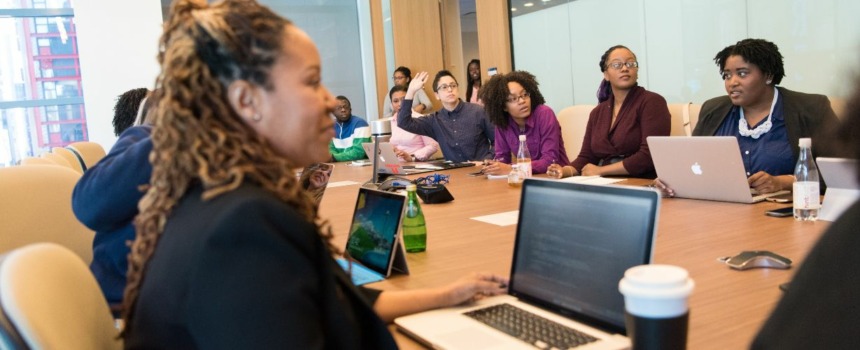The importance of mentoring in an organization is not in contest. It is a strategy that facilitates growth. Little wonder 90% of workers with mentors say they’re happy with their jobs.
However, mentoring in most companies is often one-sided. It involves only a senior worker mentoring a subordinate. Doing this only lets you harness half of the benefits possible from mentoring.
Reverse mentoring is the other half and the merits for your business are immense. Read on to learn what this practice is all about and why your company needs to start implementing it.
What is mentoring

To understand reverse mentoring, you must first know what mentoring is. Mentoring occurs when someone helps another person grow or succeed by sharing their experience, skills, exposure and knowledge with them. Mentoring can be personal or professional, but we’re sticking to professional mentorship here. Mentoring usually involves a more experienced or successful individual guiding an inexperienced, often younger, person.
The traditional model of mentorship involves a one-on-one relationship. However, in recent times, group mentoring has been introduced in organizations. This involves an individual mentoring a group of people at the same time. This model has proven to be time- and cost-effective as well as very successful.
Thus, a mentor is someone who guides someone or others using their experience, skills and knowledge. On the flip side is a mentee who receives guidance from a mentor for their progress.
What is reverse mentoring

Mentoring in reverse is when a subordinate mentors their superior. The idea behind this concept is for a junior staff member to share their skills and experience with a senior colleague to help them grow in a specific area.
This type of mentoring has become necessary as many organizations are coming to the realization that everyone has something to offer. This idea of reverse mentoring provides an opportunity to bridge the generational gap in the workplace.
Senior staff members could have been onboarded at a time when technology was not yet as advanced. On the other hand, younger intakes might be more technologically savvy. So, while senior members have a lot to mentor the junior staff on, junior staff also have a lot they can mentor their superiors on. Who then says mentoring should be one-way?
This intergenerational collaboration is what makes Mentoring in reverse special. The knowledge sharing that occurs across board helps to increase conversions by building a powerful team. Everyone grows and delivers better results for the company.
What are the roles of a mentor

A lot of people get the roles of a mentor mixed up. Some often confuse it with coaching or counseling. Find below the roles a mentor is expected to play for their mentee.
- Teaching: a mentor possesses the knowledge and skill sets a mentee needs. Thus, teaching the mentee these skills and imparting knowledge is one of the main roles of a mentor.
- Nurturing: one of a mentor’s roles is to groom a mentee. They have a duty to look out for their mentees and ensure they grow steadily.
- Encouragement: it is easy to be discouraged in one’s career journey. A mentor encourages a mentee, using their story and progress to motivate and uplift them when they feel like giving up.
- Relationship management: the mentor-mentee relationship could go sour if not well handled. It is the duty of the mentor to make sure that this relationship is healthy and serves the purpose for which it was set up.
5 benefits of reverse mentoring for your company
After understanding what this concept is all about, the next step is to know the benefits of reverse mentoring. Below are reasons your organization needs to adopt mentoring in reverse as a strategy.
1. It encourages creativity and innovation

The company tends to face a certain direction when mentoring is one-sided, getting the same results. However, with reverse mentoring, junior folks get excited to help their senior colleagues grow and they bring all their juices to the table. A lot of new ideas are brought on board and tested, leading to creativity and innovation.
2. It bridges workplace generational gap
Usually, there are various generations in a company, each with its own perspectives. Mentoring in reverse closes the gap between these generations. The older generations gain new perspectives and see things differently when the younger ones mentor them. This boosts better understanding, leading to improved productivity.
3. It fosters inclusion and equity

Gone are the days when junior colleagues feel inferior and get the impression that they do not contribute much to the company. With mentoring in reverse, everyone feels included and valued. Knowing that your boss needs you to mentor them on an aspect they’re not versed in makes you feel valuable to an organization. This strategy allows underrepresented staff members to contribute significantly to the company.
4. It builds leadership skills
Having junior colleagues mentor their seniors plants the seed of leadership in them. Mentoring is a leadership skill and letting them take the challenge at an early stage of their career builds leadership skills in them. Beyond mentoring, these junior staff will be empowered to take bolder steps and initiatives that would benefit them and the company. This could even be part of the company’s leadership development plan.
5. It promotes an atmosphere of trust and collaboration

Mentoring in reverse creates an environment where the junior staff members become freer and more accepted. Subordinates will no longer jump at the sound of their superiors’ footsteps. Whatever tension existed between generations of workers will be dissolved by this practice. This boosts trust and collaboration, opening doors for other types of activities that would bring growth to the organization.
Key elements of mentoring
Specific components must be present in a mentoring relationship. Without these elements, a mentorship arrangement can’t be said to be successful. What are these elements? Read on to find out.
Mutual understanding and agreement
Mentorship is a voluntary arrangement between the mentor and the mentee. It should not be a forced relationship. You cannot force mentorship on a mentor; likewise, a mentor cannot coerce a mentee into mentorship. Both parties must agree to be a part of the arrangement. This is very important if the best results are to be achieved. A reluctant person will not fully participate in a mentoring relationship, which will affect the outcomes.
Goal setting
There is a purpose for a mentorship arrangement. That purpose must be determined from the outset so that the impact of the mentoring can be measured. Goal setting cannot be left out in a mentoring relationship. The mentor and mentee must agree on a set goal and both work towards achieving it.
Commitment
Commitment is a big deal in mentoring. If you know you won’t be fully committed to a mentorship relationship, declining the invitation is better than going into the arrangement halfheartedly. Mentoring is time- and resources-consuming and you need total commitment to make those sacrifices.
Mutual respect
To fully enjoy a mentorship arrangement, both mentor and mentee must respect each other. Regardless of the status of either of them, there must be mutual respect. A senior colleague must not see a junior colleague they’re mentoring as inferior. Likewise, in a reverse mentoring arrangement, the junior colleague must not look down on their superior because they possess certain skills their senior colleague lacks. Both parties must accord due respect to each other.
Effective communication
For mentoring to be successful, there has to be communication. In fact, it’s safe to say effective communication is the fuel of mentoring. Both parties must communicate effectively and give regular feedback to get the best out of a mentorship relationship. Mentors and mentees should be free to ask questions, share their ideas and feelings as well as generally open up. Failure to communicate clearly can result in misconceptions and misunderstandings.
Be progressive – adopt the progressive trend of reverse mentoring
Many progressive trends are flying around today and reverse mentoring is one of them. It’s time to balance the traditional mentoring method and build intergenerational collaboration by involving the other half. Doing this will bring benefits like creativity and innovation and bridge the workplace generational gap.
Other advantages of implementing mentoring in reverse include building leadership skills, promoting inclusion and diversity and enhancing an atmosphere of trust and collaboration. For a mentoring arrangement to be successful, certain elements must be present. They include mutual understanding and agreement, goal setting, commitment, mutual respect and effective communication. Take the smart step in the right direction today and start enjoying the numerous benefits.
Moyofade Ipadeola is a Content Strategist, UX Writer and Editor. Witty, she loves personal development and helping people grow. Mo, as she’s fondly called, is fascinated by all things tech.










Comments